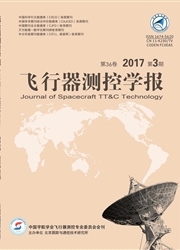

 中文摘要:
中文摘要:
中继卫星的天基测控是解决中低轨道航天器大范围、长时间、多目标测控的有效途径,但用户星到中继卫星的时延误差、多普勒频移校正误差等参数会对多目标测控带来干扰。针对该问题,首先分析了定位误差引起的时延误差、多普勒频移校正误差等因素,设计了天基多目标前向链路遥控SMA(S-band Multiple Access,S频段多址)信号形式和反向遥测链路SMA信号形式,选择与时延校正误差相匹配的LAS(Large Area Synchronous,大区域同步)码作为反向遥测信息的扩频码,建立了导航辅助的终端时延和频率预校正方案模型,可以有效消除多用户干扰。仿真表明,当Eb/N0≥10.5dB时,前向遥控信息误码率pe≤1×10^-6,反向遥测信息误码率pe≤1×10^-6,使用LAS码比Gold序列约有2dB性能改善,为基于我国天链卫星的中低轨道卫星稳定运行、载人航天交会对接以及后续空间站建设等任务的测控提供重要参考。
 英文摘要:
英文摘要:
With the rapid development of China's manned space flights,Beidou navigation and Low Earth Orbit(LEO)constellation system,Tracking and Data Relay Satellite(TDRS)provides a fundamental solution to solve the long time,high coverage and multi-satellites Tracking,Telemetry and Command(TTC)problems for its space-based design thinking.In this process,parameters such as time delay of user satellites to relay satellites and correction error of Doppler frequency shift will bring interference to multi-object TTC.In order to solve this problem,this paper analyzes factors such as time delay,Doppler frequency shift correction error due to positioning error,design S-band Multiple Access(SMA)signal form of forward link and reverse link based on the multi-object,choose Large Area Synchronous(LAS)code matching the time delay correction error as the spread spectrum code of the reverse telemetry information,and then proposes a navigation aided terminal delay and frequency pre-correction scheme model,which can eliminate multi-user interference effectively.Simulation results show when Eb/N0 of reverse link is more than 10.5dB,the bit error rate of telemetry information is less than 1×10^-6,which is economized 2dB compared with Gold sequence.It provides an important reference to space-based TTC for the stable operation of satellites in orbit,manned space rendezvous and docking and subsequent space station construction,etc.
 同期刊论文项目
同期刊论文项目
 同项目期刊论文
同项目期刊论文
 期刊信息
期刊信息
